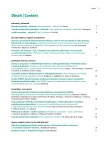-
Medical journals
- Career
Toxic epidermal necrolysis
Authors: Dina Odarčenková; Milan Kvapil
Authors‘ workplace: Interní klinika 2. LF UK a FN Motol Praha
Published in: Vnitř Lék 2016; 62(1): 62-69
Category: Case Reports
Overview
Toxic epidermal necrolysis is a rare, acute and life-threatening disorder manifested by extensive separation of the epidermis and mucosal surfaces. It is a serious adverse response to administered drugs, mostly antibiotics, anticonvulsants or NSAIDs. First described by Scottish dermatologist Alan Lyell in 1956, it is also known as Lyell’s syndrome. Mortality of the disease is high, therefore its early diagnosis is crucial and immediate initiation of appropriate patient care necessary. It is a rare disease with a very low incidence and serious prognosis, which is a considerable hindrance to undertaking large randomized clinical studies. It is therefore difficult to evaluate the effectiveness of various therapeutic options. As the most promising so far appears the administration of intravenous immunoglobulins, apparently reaching improvement in the clinical condition of the patient, with a good tolerances and minimal side adverse effects. New experimental techniques endeavour to seek a way to the therapy through targeted influencing of granulysin as the major cytotoxic mediator.
Key words:
adverse drug reaction – corticosteroids – cyclosporine A – granulysin – intravenous immunoglobulins – interdisciplinary team care – keratinocyte apoptosis – medical history – Nikolsky´s sign – plasmapheresis – SCORTEN score – Stevens-Johnson syndrome – toxic epidermal necrolysis
Sources
1. Schwartz RA, McDonough PH, Lee BW. Toxic epidermal necrolysis – Part I. Introduction, history, classification, clinical features, systemic manifestations, etiology, and immunopathogenesis. J Am Acad Dermatol 2013; 69 : 173.e1–13; quiz 185–186. Dostupné z DOI: <http://dx.doi.org/10.1016/j.jaad.2013.05.003>>.
2. Hussain W, Craven NM. Toxic epidermal necrolysis and Stevens-Johnson syndrome. Clin Med (Lond) 2005; 5(6): 555–558.
3. Tomasini C, Derlino F, Quaglino P et al. From erythema multiforme to toxic epidermal necrolysis. Same spectrum or different diseases? G Ital Dermatol Venereol 2014; 149(2): 243–261.
4. Knowles S, Shear NH. Clinical risk management of Stevens-Johnson syndrome/toxic epidermal necrolysis spectrum. Dermatol Ther 2009; 22(5): 441–451.
5. Mockenhaupt M. The current understanding of Stevens-Johnson syndrome and toxic epidermal necrolysis. Expert Rev Clin Immunol 2011; 7(6): 803–813.
6. French LE. Toxic epidermal necrolysis and Stevens-Johnson syndrome: our current understanding. Allergol Int 2006; 55(1): 9–16.
7. Schwartz RA, McDonough PH, Lee BW. Toxic epidermal necrolysis – Part II. Prognosis, sequelae, diagnosis, differential diagnosis, prevention, and treatment. J Am Acad Dermatol 2013; 69(2): 187.e1–16; quiz 203–204. Dostupné z DOI: <http://dx.doi.org/10.1016/j.jaad.2013.05.002>.
8. Harr T, French LE. Toxic epidermal necrolysis and Stevens-Johnson syndrome. Orphanet J Rare Dis 2010; 5 : 39. Dostupné z DOI: <http://dx.doi.org/10.1186/1750–1172–5-39>.
9. Castelain F, Humbert P. Toxic epidermal necrolysis. Curr Drug Saf 2012; 7(5): 332–338.
10. Michaels B The role of systemic corticosteroid therapy in erythema multiforme major and Stevens-Johnson syndrome – a review of past and current opinions. J Clin Aesthet Dermatol 2009; 2(3): 51–55.
11. Huang YC, Li YC, Chen TJ. The efficacy of intravenous immunoglobulin for the treatment of toxic epidermal necrolysis: a systemic review and meta-analysis. Br J Dermatol 2012; 167(2): 424–432.
12. Teo L, Tay YK, Liu TT et al. Stevens-Johnson syndrome and toxic epidermal necrolysis: efficacy of intravenous immunoglobulin and a review of treatment options. Singapore Med J 2009; 50(1): 29–33.
13. Nešpor D, Lipový B, Gregorová N. Cyklosporin A v terapii toxické epidermální nekrolýzy. Dermatol praxi 2011; 5(3): 156–159.
14. Narita YM, Hirahara K, Mizukawa Y et al. Efficacy of plasmapheresis for the treatment of severe toxic epidermal necrolysis: Is cytosine expression analysis useful in predicting its therapeutic efficacy? J Dermatol 2011; 38(3): 236–245.
15. Beder DS. Toxic epidermal necrolysis. Lancet 1998; 351(9113): 1417–1420.
Labels
Diabetology Endocrinology Internal medicine
Article was published inInternal Medicine

2016 Issue 1-
All articles in this issue
- Significance of alanine aminotransferase screening in blood donors for risk reduction of hepatitis B and C transmission by haemotherapy
- “3P (Patient-Pulse-Prognosis) in heart failure” survey: focus on heart rate
- Changes in the prognosis and treatment of Waldenström macroglobulinemia. Literature overview and own experience
- Gene mutations connected to Waldenstöm macroglobulinemia
- The SPRINT Research. A Randomized Trial of Intensive versus Standard Blood-Pressure Control
- Rare diagnostics of infective endocarditis after kidney transplantation
- A rare case of mobile atherosclerotic plaque with a high embolic potential in the femoral artery
- Dangerous cucumbers – Leyll’s syndrome
- Toxic epidermal necrolysis
- EASD Postgraduate Course of Clinical Diabetes and its Complications, Prague 2015
- Internal Medicine
- Journal archive
- Current issue
- Online only
- About the journal
Most read in this issue- Toxic epidermal necrolysis
- Changes in the prognosis and treatment of Waldenström macroglobulinemia. Literature overview and own experience
- Significance of alanine aminotransferase screening in blood donors for risk reduction of hepatitis B and C transmission by haemotherapy
- Gene mutations connected to Waldenstöm macroglobulinemia
Login#ADS_BOTTOM_SCRIPTS#Forgotten passwordEnter the email address that you registered with. We will send you instructions on how to set a new password.
- Career

